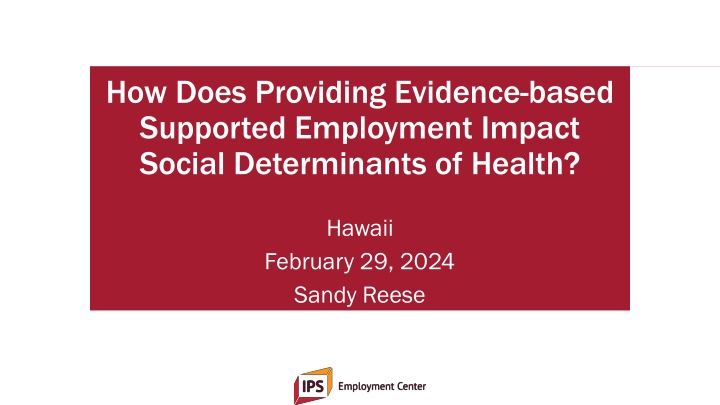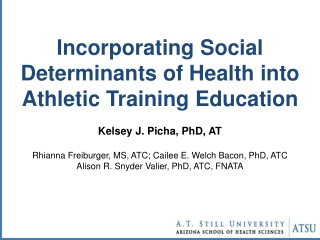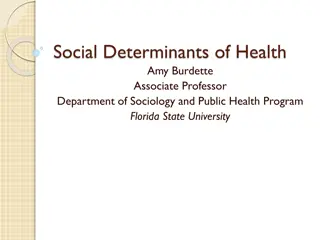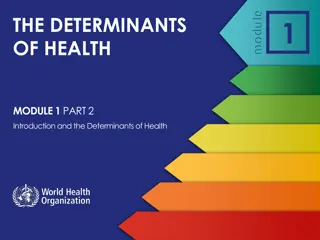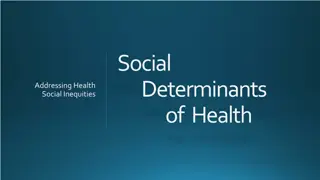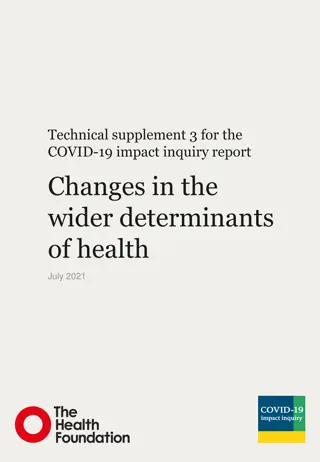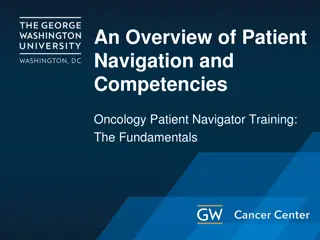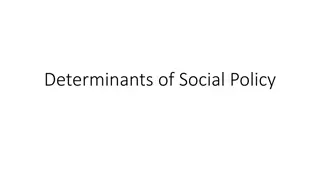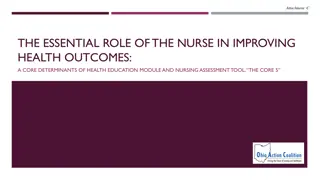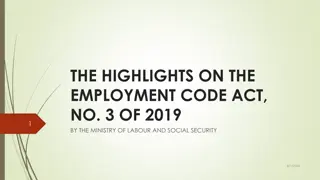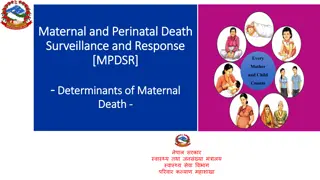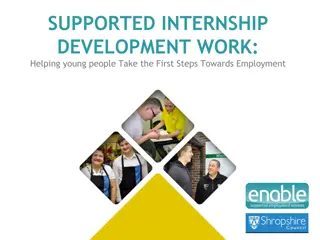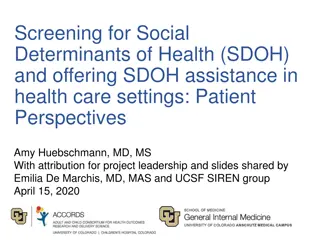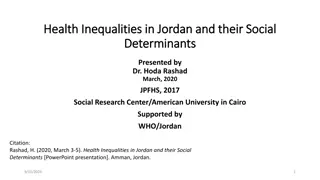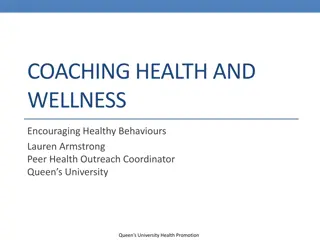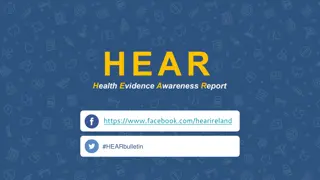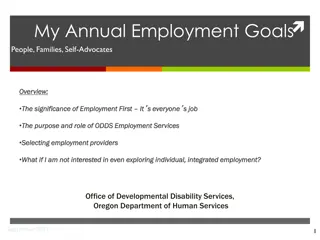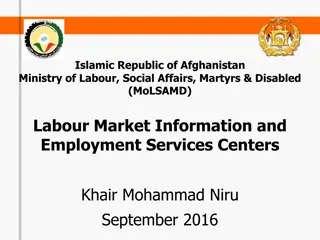Impact of Evidence-based Supported Employment on Health and Social Determinants
Providing evidence-based supported employment can positively impact social determinants of health by addressing economic stability, reducing risk factors for preventable illnesses, and improving access to quality healthcare. Employment plays a crucial role in mental health intervention and can help mitigate the higher risk of illnesses faced by individuals with mental health disorders. By reducing poverty, social isolation, and trauma, employment contributes to overall health and well-being.
Download Presentation

Please find below an Image/Link to download the presentation.
The content on the website is provided AS IS for your information and personal use only. It may not be sold, licensed, or shared on other websites without obtaining consent from the author.If you encounter any issues during the download, it is possible that the publisher has removed the file from their server.
You are allowed to download the files provided on this website for personal or commercial use, subject to the condition that they are used lawfully. All files are the property of their respective owners.
The content on the website is provided AS IS for your information and personal use only. It may not be sold, licensed, or shared on other websites without obtaining consent from the author.
E N D
Presentation Transcript
How Does Providing Evidence-based Supported Employment Impact Social Determinants of Health? Hawaii February 29, 2024 Sandy Reese
What is the connection between employment and health? Employment is a critical mental health intervention. Drake and Wallach (2020) 2
Social Determinants of Health Access to quality healthcare Access to quality education Social and community context Neighborhood and built environment CDC for Disease Control and Prevention CDC 24/7: Saving lives, Protection People
Social Determinants of Health Economic stability: The connection between the financial resources people have - income, cost of living and socioeconomic status and their health. This area includes key issues such as poverty, employment, food security and housing stability. CDC for Disease Control and Prevention CDC 24/7: Saving lives, Protection People
Mortality rate for people with mental illness According to the World Health Organization, people with serious mental health disorders die 10-25 years earlier than the general population. The vast majority of deaths of people with serious mental illness are preventable.
Higher risk of illness People with mental illness have increased risk of heart disease and other preventable conditions due to: Poverty, social isolation and trauma Lack of access to quality health care Psychopharmaceutical effects Substance use Tobacco Obesity SAMHSA: What Health Providers and Organizations Need to Know About Wellness
How might employment reduce risk factors for preventable illnesses? Reduce poverty, social isolation and trauma: Earned income and a sense of contributing and belonging to the community. Improve access to quality health care: Employer paid benefits. Psychopharmaceutical effects: IPS team works closely with the person s prescriber in order to coordinate treatment.
How might employment reduce risk factors for preventable illnesses? Substance use: Employment gives people a sense of purpose, a reason to get up in the morning and reduces substance use. Tobacco: Most employers do not allow smoking on the job. Obesity: Employment fills in for boredom and sedentary time.
Discussion How do you see employment impacting health risk factors for people with behavioral health conditions?
Positive Impact of Competitive Employment for People with Mental Illness Benefits of work for people with mental illness similar to Benefits of work for people with mental illness similar to those for general population: those for general population: increased self-esteem, improved financial security, reduced mental health symptoms, less social isolation, reduced substance use, and reduced health care costs (Drake, 2020; Gibbons, 2019; Luciano, 2014) 10
If employment is good, why is there such a large disparity between statewide employment rates and the numbers of people with mental health conditions working?
This is the 2022 Uniform Reporting System (URS) Output Tables for Hawaii. The URS state reporting system is collected annually to support the Community Mental Health Services Block Grant program. State Mental Health Authorities report on National Outcome Measures (NOMS), evidence-based practices, and utilization measures providing an overview of state mental health delivery systems. People with People with Mental Illness Mental Illness General Population General Population Difference Difference Employment Rate in United States 96.3% 21.7% 74.6% Employment Rate in Hawaii 96.5% 14.4% 82.1% Target group for IPS services!
Theres probably a lot of people with mental illness who want to work, but may need help to reach their goal
Need for Employment Services Expressed Interest in Employment Reported in 11 Surveys Over 60% of people with serious mental illness want to work, but less than 20% employed. Study % Survey Population Rogers (1995) Bedell (1998) Mueser (2001) McQuilken (2003) Drebing (2004) Woltmann (2009) Frounfelker (2011) 72% clients with co-occurring substance use Ramsay (2011) 78% young adults experiencing early psychosis Wescott (2015) 77% community survey of people with schizophrenia Knaeps (2015) 45% psychiatric inpatients Livermore (2017) 48% SSDI/SSI beneficiaries with mental illness Mean 63% 71% statewide survey of people with mental illness 69% sheltered workshop participants 61% study of family intervention 55% clubhouse members 53% veterans in a VA-sponsored vocational program 70% clients in psychiatric rehabilitation program Only 2% of people who could benefit have access to effective employment services. 14
Question: If work is so good for people, then why isn t it seen (along with housing) as a central focus of the public mental health system?
Funding Employment Services There typically is not one source of funding for employment services but instead a need to braid funding. Medicaid Medicaid Waivers Vocational Rehabilitation State Block Grant $
Leadership Buy-in for IPS Successful implementation of IPS and other evidence- based practices depends upon strong leadership for the new program, as demonstrated by the National Evidence-Based Practices Project.
Provider Misinformation Lack of understanding about SSI/SSDI benefits planning. Many providers were taught that work is too stressful. What comes first mentality we are not saying that people shouldn t work but they need to be housed or in treatment first.
People are their own best judges of when they are ready to work Research has demonstrated that desire to work helps people overcome many different barriers to employment. Most of us are unable to reliably predict who can work. Employment is a human right. Effects of poverty are terrible people live on the fringes of their communities, poorer health, less self-esteem, depression, legal problems, more substance use.
When we dont ask people about employment, does that send a message? What message?
Since we know that work is good for overall health, what can we do? Self examination: What message do you give staff and clients about the importance of employment? Has leadership communicated how employment (IPS) supports the mission of the agency and helps clients with their recovery. Include questions about interest in employment on agency intake and treatment plans. Display written postings (e.g., brochures, bulletin board, posters) about working and IPS employment services in the lobby and other waiting areas. Ensure that people being served are offered assistance in obtaining comprehensive benefits counseling.
Support ways for people being served to share work stories with other participants and staff Kickoff event with agency leadership, staff, people that receive services, Vocational Rehabilitation, and funders. Provide opportunities for participants to share their back to work stories in agency groups, social events, staff events, and other gatherings. Have an employer come to the agency to share about their workplace and what they look for in candidates.
Collect and Report Data Agencies can track how many people are working and analyze annual trends. IPS programs can share information on numbers of people enrolled in IPS, people working, in school, how many job starts, etc. Data can be shared with mental health teams, vocational teams, agency leadership, State and regional MHDS, Vocational Rehabilitation, and other stakeholders.
Guard against the tyranny of low expectations Does leadership pay attention to low expectations (what would you do if your son or daughter came home and told you that they could no longer work)? Are there conversations about helping people to create exit plans? What is your definition of recovery for people with behavioral health conditions?
How do we fund IPS employment services The key is to partner and collaborate across silos. Get all stakeholders (e.g., Vocational Rehabilitation, Medicaid, State and Regional MCO s), to sit down at a meeting and discuss a state plan to support IPS services.
Provide strengths-based services The strengths-based approach was developed in response to the predominantly deficit-based medical model in mental health. Rather than seeing people with mental illness as permanently deficient, the strengths-based approach highlights people s assets and potential for recovery. Focusing on people s strengths improves the client- specialist relationship and vocational outcomes.
What can mental health staff do to promote employment? Sometimes, mental health practitioners ask all of their clients about work, but are unsure what to do if a person says No. Think about a variety of ways to ask how employment might fit into the person s life. How would your life be different if you worked? What would be some good things about being employed? The not so good things? How would a job affect your relationships with other people? What are your skills and strengths?
Mental Health Practitioners could also ask: Would you like to learn more about our employment services? Would you like me to introduce you to one of our employment/education staff? Would you like to hear how your benefits would be impacted by returning to work?
Change program services to accommodate working people s schedules Are psychiatrists available after 5 p.m.? Are support groups and counseling sessions available after 5 p.m.?
What can mental health staff do to promote employment? If employment is a person s treatment plan goal, it s everyone s business to help them, not just the employment staff. Be creative and brainstorm good job matches according to the person s strengths, skills, and previous employment history. Keep your eyes open for potential jobs and share leads with the employment staff.
Quotes From IPS Participants When you are working, you are part of the real world. You feel connected. Having a job gives me stability. I have something to look forward to every day. In the past, people might have used labels to describe me such as homeless, mentally ill, and welfare mother. Now my titles are financial administrator, college student, and working mom.
Thank You Sandy Reese IPS Employment Center Sandra.reese@nyspi.columbia.edu www.ipsworks.org
